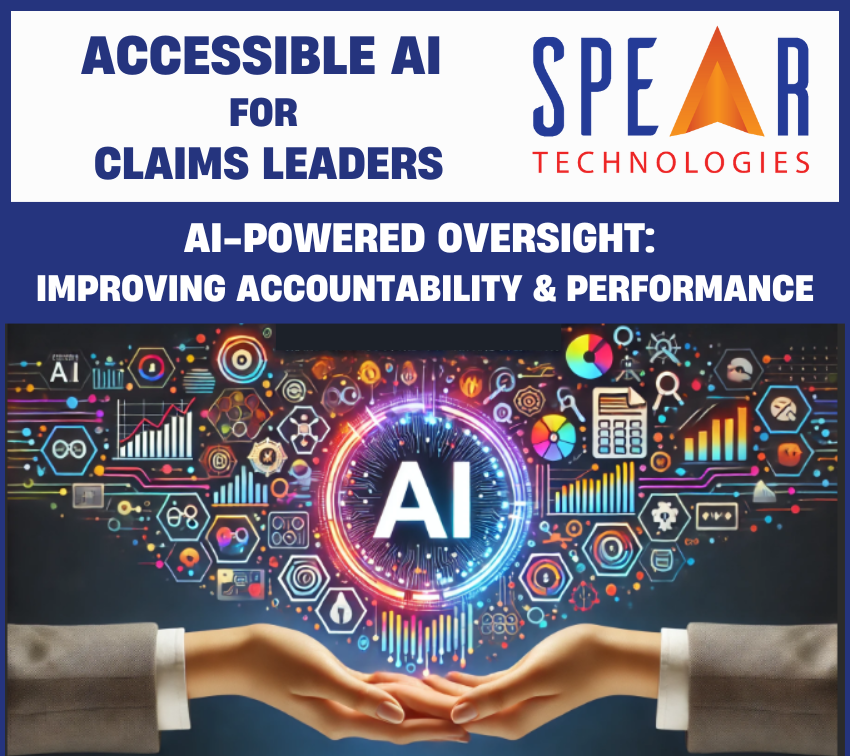Accessible AI for Claims Leaders: AI-Powered Oversight: Improving Accountability and Performance

For claims executives, oversight is not just about monitoring, it’s about accountability, transparency, and measurable performance. Whether managing in-house adjusters or outsourced vendors, leaders need timely insights into performance trends, compliance gaps, and escalation risks. Without these, costs climb, litigation rises, and stakeholders lose trust.
In our last article, Accessible AI for Claims Leaders: Stopping Costly Claims Before They Escalate, we explored how Accessible AI empowers teams to spot and intervene in high-risk claims before severity and litigation spiral out of control. In this installment, we turn to another equally critical use case: AI-powered oversight to strengthen accountability, performance, and vendor transparency.
Why Oversight Matters More Than Ever
Claims organizations today operate in a complex ecosystem of internal teams, TPAs, outside counsel, IMEs, medical providers, and technology vendors. Each plays a role in the claims lifecycle—but leaders remain accountable for the end result.
Traditional oversight tools—static reports, after-the-fact audits, and generic dashboards—simply don’t provide the real-time visibility executives need. The result?
- Performance gaps go unnoticed until costs are entrenched
- Inconsistencies across teams or vendors undermine compliance
- Stakeholders lack confidence in how claims are being managed
Accessible AI changes this equation by delivering actionable oversight—surfacing the insights that matter most, when they matter most.
Empowering Business Users with AI They Can Shape
Before diving deeper into AI-Powered Oversight, it’s important to revisit the foundation of Accessible AI. At the core of every use case in this series—including early risk detection—is the idea that AI must be usable and adaptable by business leaders themselves. If you’ve read the first few articles, this will be a refresher. If you’re joining us here, it’s essential context.
One of the most transformative aspects of accessible AI in insurance is the shift from developer-led to business-led model interaction. In traditional setups, any customization or retraining of AI models requires intervention from IT teams, data scientists, or external vendors. This dependency creates bottlenecks, slows innovation, and disconnects model development from those who understand the business problems best—your underwriters, claims adjusters, fraud investigators, and customer experience teams.
Why Business-User Accessibility Is a Game-Changer
When AI tools are designed for business users, the result is more responsive, agile, and relevant model development. Empowering business users to adapt and train AI models on their own yields multiple advantages:
- Faster Time-to-Value: No waiting on IT backlogs or vendor response times
- Higher Accuracy: Models reflect real-world operational needs and are continually refined by domain experts
- Greater Adoption: Tools that align with existing workflows and skill sets see higher engagement
- Scalable Innovation: Business teams become active participants in digital transformation, not passive consumers
Some tangible benefits to empowering teams.
The numbers show just how impactful it can be when claims teams are empowered with AI-driven tools:
- Operational Efficiency: Streamlined processes and automation can reduce administrative and processing costs by up to 30%.
- Faster Claims Resolution: Shorter cycle times result in about 28% higher reimbursement efficiency, reducing leakage and improving outcomes.
- Worker’s Compensation Savings: Catastrophic claims make up just 2% of cases but drive more than 30% of total costs. Preventing even a fraction of these escalations can save insurers millions annually.
- Fewer Denials and Rework: Reducing documentation, coding, and eligibility errors cuts denials by 10–15%, ensuring more claims are paid correctly the first time.
With these benefits in reach, claims leaders can no longer afford to wait until problems surface. This is where Accessible AI changes the game—streamlining processes, reducing manual workloads, and enabling earlier, more accurate triage.
Surfacing Performance Insights with Accessible AI
Accessible AI platforms analyze structured and unstructured data across claims operations to spotlight trends that often stay hidden in traditional reporting. For example, AI can:
- Flag adjusters or vendors with unusually high litigation rates
- Detect compliance gaps in medical bill review, FNOL handling, or escalation protocols
- Identify cycle-time delays by claim type, geography, or vendor partner
- Surface patterns of reserve strengthening that signal inconsistent claim handling
The difference is that these insights aren’t buried in static spreadsheets—they’re delivered through real-time dashboards, role-based alerts, and virtual agents designed for business leaders.
Virtual Agents and Dashboards for Vendor Transparency
Vendor oversight is one of the most challenging responsibilities for claims leaders. Whether it’s a TPA handling workers’ comp claims or a law firm managing subrogation, leaders need a clear, unbiased view of performance.
Accessible AI supports this with:
- Virtual Agents that monitor vendor performance continuously, flagging deviations in compliance, cost, or outcomes
- Dashboards that compare performance across vendors, regions, or lines of business
- Configurable alerts that allow business leaders—not IT—to set thresholds for escalation
This level of transparency reduces vendor reliance, strengthens accountability, and creates a fact-based foundation for conversations with partners.
Strengthening Compliance and Consistency
Consistency is at the heart of effective claims management. Accessible AI helps ensure that policies, protocols, and best practices are applied evenly—across in-house teams, TPAs, and other external partners.
By aligning oversight to data-driven benchmarks, executives can:
- Reduce compliance risk in regulated lines like healthcare and workers’ comp
- Ensure consistent claimant experiences across geographies and vendors
- Minimize reputational risk by demonstrating active governance to boards, regulators, and reinsurers
Case Study: Cleaner Data Flow, Fewer IT Patches
One large self-insured organization struggled with fragmented reporting across multiple TPAs. Each vendor used different reporting formats, requiring IT to patch together spreadsheets and build custom extracts—an approach that was costly, brittle, and often weeks out of date.
By implementing Accessible AI with low-code integrations, the organization:
- Eliminated the need for IT “patches” by consolidating data directly into the AI-driven oversight dashboard
- Gained near real-time visibility into vendor performance
- Reduced compliance exceptions by 30% in the first year
- Improved accountability in vendor contracts by shifting to transparent, data-driven SLAs
Why It Matters for Claims Leadership
For executives, the stakes are clear: you are accountable for outcomes, even when the work is outsourced. Accessible AI strengthens this accountability by providing:
- Earlier visibility into performance gaps
- Stronger vendor management through unbiased transparency
- Improved compliance and consistency across the entire claims ecosystem
- Reduced IT dependency by equipping business users to configure and manage oversight tools themselves
What’s Next in the Series
In this article, we examined how Accessible AI drives accountability and transparency in claims operations. In the next installment, we’ll explore how Virtual Agents for Vendor Interactions can streamline communications, improve satisfaction, and reduce administrative burden—without adding staff.
Ready to see how SpearClaims™ can help your team improve oversight, accountability, and performance?
Schedule a Demo to see how SpearClaims™ with accessible AI equips claims executives with greater transparency and governance.
Request Pricing to learn how surprisingly affordable it is to modernize oversight, manage costs, and deliver better outcomes.



